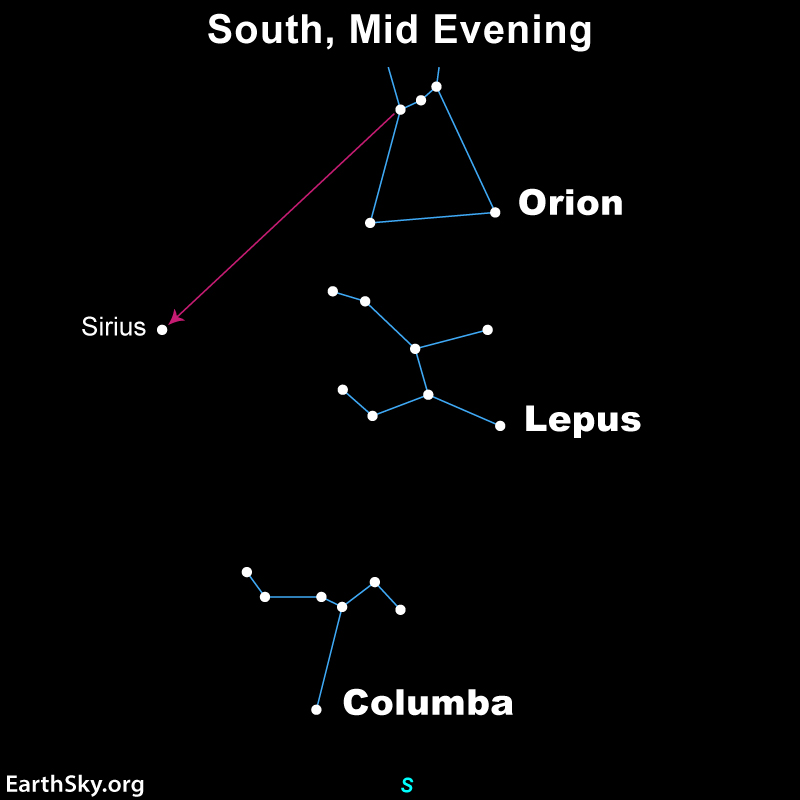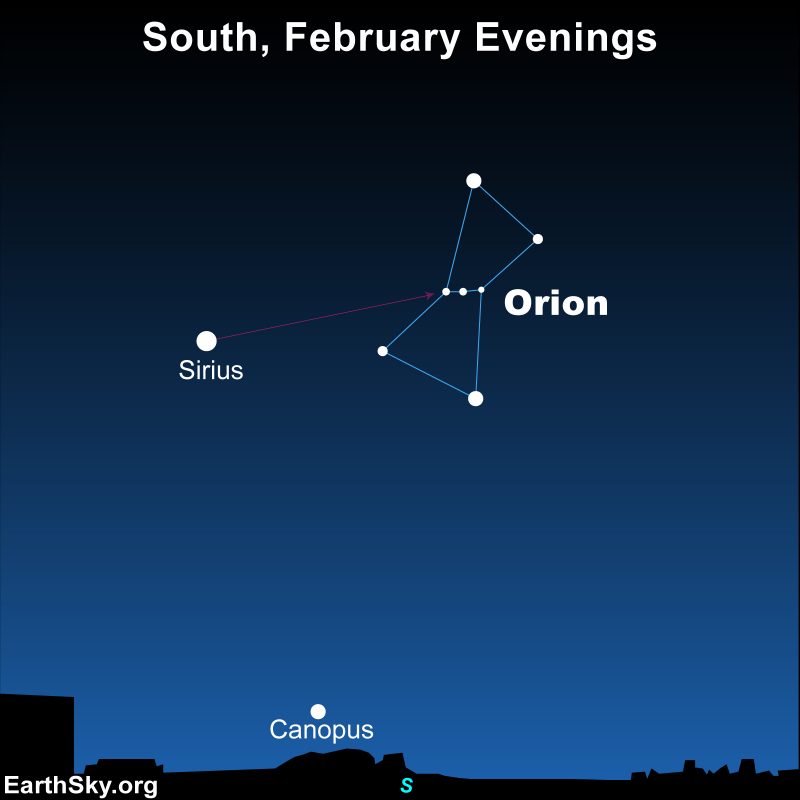
Finding the Hare and Dove
Tonight, look for Orion the Hunter, one of the easiest to find of all constellations. In fact, it’s recognizable for a short, straight row of three medium-bright stars. And these three stars represent Orion’s Belt. You’ll have no trouble spotting the constellation Orion the Hunter and the bright star Sirius nearby. You can find Orion and Sirius even on bright moonlit nights. But to see Lepus the Hare and Columba the Dove, you need a moderately dark sky with little to no moonlight.
As seen from latitudes in the Northern Hemisphere, you’ll find Orion in the south around 8 to 9 p.m. As seen from the equatorial regions, Orion is more overhead. From the temperate parts of the Southern Hemisphere, Orion is in the northern sky (hold our chart upside down).
Now about the Hare and the Dove at Orion’s feet …

Lepus and Columba lore
On old sky maps, the mighty Hunter of the ancient myths is seen poised with an upraised club and shield, as though fending off the raging Bull, Taurus. And then Lepus and Columba seem to cower at the Hunter’s feet.
Lepus the Hare was described by Roman stargazers as being “swift,” “light-footed,” and “eared.” Can you see all that in these stars? Then, you’ve got a good imagination!
Columba the Dove is south of the Hare. This little constellation is sometimes ignored in Northern Hemisphere books about the sky, probably because it is so far south as seen from the U.S. Richard Hinckley Allen, in his classic book “Star Names: Their Lore and Meaning,” wrote that Columba was first seen in constellation drawings in 1603. But, he said, there are hints in early writings that stargazers knew the name Columba, and identified a Dove here, over 17 centuries ago.
So watch for the Hare and the Dove at the feet of Orion. Seeing them binds your thoughts to those of the early stargazers!
Bottom line: Lepus the Hare and Columba the Dove are two faint constellations near the easy-to-find constellation Orion. You need a dark sky to see them.
The post Hare and Dove at Orion the Hunter’s feet first appeared on EarthSky.
from EarthSky https://ift.tt/lcCxOur

Finding the Hare and Dove
Tonight, look for Orion the Hunter, one of the easiest to find of all constellations. In fact, it’s recognizable for a short, straight row of three medium-bright stars. And these three stars represent Orion’s Belt. You’ll have no trouble spotting the constellation Orion the Hunter and the bright star Sirius nearby. You can find Orion and Sirius even on bright moonlit nights. But to see Lepus the Hare and Columba the Dove, you need a moderately dark sky with little to no moonlight.
As seen from latitudes in the Northern Hemisphere, you’ll find Orion in the south around 8 to 9 p.m. As seen from the equatorial regions, Orion is more overhead. From the temperate parts of the Southern Hemisphere, Orion is in the northern sky (hold our chart upside down).
Now about the Hare and the Dove at Orion’s feet …

Lepus and Columba lore
On old sky maps, the mighty Hunter of the ancient myths is seen poised with an upraised club and shield, as though fending off the raging Bull, Taurus. And then Lepus and Columba seem to cower at the Hunter’s feet.
Lepus the Hare was described by Roman stargazers as being “swift,” “light-footed,” and “eared.” Can you see all that in these stars? Then, you’ve got a good imagination!
Columba the Dove is south of the Hare. This little constellation is sometimes ignored in Northern Hemisphere books about the sky, probably because it is so far south as seen from the U.S. Richard Hinckley Allen, in his classic book “Star Names: Their Lore and Meaning,” wrote that Columba was first seen in constellation drawings in 1603. But, he said, there are hints in early writings that stargazers knew the name Columba, and identified a Dove here, over 17 centuries ago.
So watch for the Hare and the Dove at the feet of Orion. Seeing them binds your thoughts to those of the early stargazers!
Bottom line: Lepus the Hare and Columba the Dove are two faint constellations near the easy-to-find constellation Orion. You need a dark sky to see them.
The post Hare and Dove at Orion the Hunter’s feet first appeared on EarthSky.
from EarthSky https://ift.tt/lcCxOur

Aucun commentaire:
Enregistrer un commentaire